

Almanac Table of Contents | Chapter Seven Table of Contents | TEC Home Page
NEXT PAGE * PREVIOUS PAGE Go to page 1*2*3*4*5*Notes

By the time white settlers arrived in Texas, indigenous tribes had been burning coal for many millennia. Between 8,000 and 10,000 years ago, tribal groups near Lake Lewisville were using lignite to heat their homes and cook their food. Archaeological sites in Bastrop County contain burned lignite dating back 5,000 years. Throughout the early 1800s settlers utilized coal they found on the surface and by 1850, small scale mining had begun.
Today, Texas leads the nation in coal consumption by a large margin. In 1993, Texas used 96 million tons of coal. By comparison, Indiana, the number two coal-consuming state, used about 60 million tons of coal.(53) Nearly 95 percent of the coal consumed in Texas was used to generate electricity.(54)
Texas mines produce two-thirds of the coal consumed in the state. Some 56 million tons of lignite are mined in Texas annually. The sixth and twelfth largest coal mines in America are located in Texas. The Martin Lake and Monticello mines, both owned by Texas Utilities Mining Co., together produce nearly 25 million tons of lignite per year.(55)
Texas has more than 24 billion tons of lignite that can be recovered through conventional strip mining methods. At current rates of production, Texas' coal supply will last about 400 years.(56) In addition, the state contains another 35 billion tons of coal in deep reserves. All told, the state's coal deposits contain the energy equivalent of more than 100 billion barrels of oil.
Coal consumption in Texas is rising faster than any other form of energy. By 2030, the state's coal consumption is expected to be about 180 million tons per year, twice as much as the state consumed in 1990.(57) However, the state's appetite for coal has caused serious pollution problems around the state. Five of the top ten sources of air pollution in the state are coal-fired electric power plants.(58) Studies have linked elevated selenium levels in a number of East Texas Lakes with nearby coal-fired power plants.(59)
Burning coal also produces sulfur dioxide, an air pollutant that can cause acid rain. Acid rain poses a serious threat to East Texas lakes, which have little ability to counter acidic input.(60) In addition to the air quality problems presented by coal consumption, strip mining presents a range of problems. Since 1982, more than 52,000 acres of land in the state has been strip mined for lignite.(61) Adequate reclamation of strip mined property is expensive and time consuming. Often, sites are re-planted with just one type of plant material. Biologists point out that the resulting monoculture does not support a diversity of wildlife.(62) In addition, the strip mined land can be subject to subsidence and erosion.
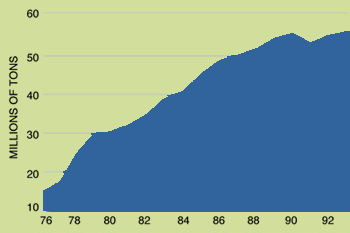
Source: Railroad Commission of Texas.
The Texas economy is changing. The service sector and light manufacturing companies are growing rapidly. The new, high-technology companies rely on computers and the microchip to speed information and products to consumers. But the emerging information economy depends on electric power. So do our air conditioners, answering machines, personal computers, microwave ovens, tape recorders and a panoply of other consumer products.
The burgeoning Texas economy and the state's rapidly growing population have caused a surge in demand for electricity. From 1970 to 1990, electricity consumption in Texas more than doubled.(63) Without a change in the pattern of consumption or major conservation efforts, the demand for electricity in Texas will require utilities to build 90 new power plants over the next 15 years.(64) These new plants could increase the state's electrical capacity by almost 25 percent.(65)
Texas produces and consumes more electricity than any other state.(66) In 1991, Texans paid $14 billion for electricity while consuming 241 million megawatt hours of electricity.(67) Twenty-seven electric utilities are currently operating 312 generating stations in Texas.(68) These facilities have a combined net capacity of 60,687 megawatts. Of the 27 utilities, nine are investor-owned, five are electric cooperatives, five are federal or state agencies and eight are owned by municipalities.
Much of the new demand for electric power is coming from the residential sector, where electricity consumption is growing rapidly. In 1970, electricity accounted for 32 percent of the energy needs in the average home. By 1990, electricity supplied 54 percent of residential energy needs. By the year 2000, that figure is expected to rise to 56 percent and by the year 2030, electricity may supply 61 percent of all home energy needs.(69)
In 1992, Texas residents paid about 6.5 cents per kilowatt hour for electricity.(70) The Public Utilities Commission of Texas estimates that by the year 2000, consumers will be paying 10.4 cents per kilowatt hour.(71) In addition to the rising cost of electricity, Texas is facing environmental problems caused by electricity production. Texas is the country's largest consumer of coal (more than 90 million tons per year), and the power plants that burn coal pump millions of tons of carbon dioxide, sulphur dioxide (which can cause acid rain), nitrogen oxide and other pollutants into the atmosphere every year. (See Air Chapter for further discussion.)
In 1977, natural gas accounted for 86 percent of the fuel used to generate electric power in Texas. But in 1978, Congress passed the Powerplant and Industrial Fuel Use Act, which required utilities to phase out the use of natural gas as a boiler fuel by 1990. Designed as a response to perceived natural gas shortages, this requirement was later repealed when new gas supplies were discovered. However, by then, many Texas utility companies had begun developing coal supplies, which were viewed as a way to diversify their power-generation base. Today, about 40 percent of all the electricity consumed in Texas is derived from the burning of natural gas.(72) Half of the state's electricity is derived from burning coal. The balance comes from nuclear power, hydropower and renewables.
In 1990, electric power generation in the state produced 66 percent of the total sulfur dioxides, 37 percent of total nitrogen oxides and 35 percent of all the carbon dioxide emitted into the air in Texas.(73) As noted above, coal-fired power plants have been linked to acidification in several East Texas lakes. The same lakes have also been contaminated by selenium, a heavy metal linked to the coal-fired power plants.
The question of global warming has also not been fully assessed. Scientists from around the world believe that carbon dioxide buildup in the atmosphere will cause a gradual warming of the Earth, which could have catastrophic effects on agriculture and coastal zones. Fossil fuel-fired electric power plants produce millions of tons of CO2 per year. (See section on air). Some environmental groups favor new regulations that would change the way Texas' electric utilities operate. Called integrated resource planning, the program would encourage utilities to increase efficiency programs. In addition, it would require utilities to take into account the cost of the pollutants that they emit. Many other states, including Nevada, Oregon and New York have adopted similar regulations. But thus far, the Texas Legislature has not required Texas power producers to factor efficiency and pollution issues into their decision-making process.
Advances in efficiency could help slow the demand for electricity. High efficiency appliances, lights and motors could go a long way toward reducing Texas' demand for electricity. (See efficiency section below).
Source: Central Power & Light, Watts New, March 1994, 3.
Source: Austin Chronicle, from the Department of Energy.
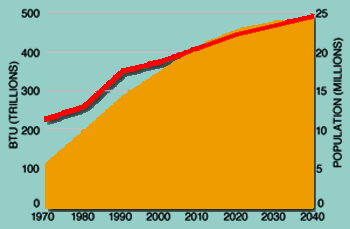
Source: Railroad Commission of Texas, State of Texas Energy Policy Partnership, Vol. 2, 293.
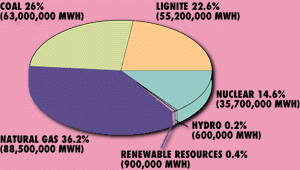
In 1994, almost half of Texas' electricity was generated from coal and lignite. Another 36 percent came from natural gas and 15 percent from nuclear plants. Hydropower and other renewables contributed less than one percent.
Source: Texas Comptroller of Public Accounts and Public Utility Commission.
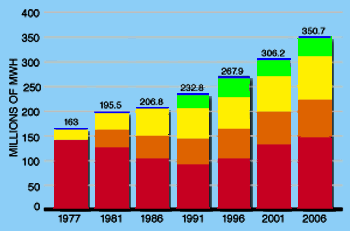
In 1977, natural gas accounted for 86 percent of the fuel used to generate electric power in Texas. Increasing use of coal, lignite and nuclear power during the 1980s reduced reliance on natural gas to less than 40 percent of total generation by 1991. Because of its clean burning characteristics, however, gas is expected to increase its share to 42 percent by 2002.
Source: Texas Comptroller of Public Accounts and Public Utility Commission.
| ELECTRIC RATE COMPARISON | |
|---|---|
| TEXAS UTILITIES | RESIDENTIAL 1000 KWH JUNE, 1994 |
| Investor Owned | |
| CPL [N] | 87.26 |
| EPE [N] | 101.19 |
| GSU [N] | 77.01 |
| HL&P [N] | 87.96 |
| SESCO | 75.66 |
| SPS | 65.29 |
| SWEPCO | 75.06 |
| TNP | 93.07 |
| TU Electric [N] | 87.19 |
| WTU | 85.22 |
| Cooperatives | |
| Bluebonnet EC | 67.38 |
| Denton County EC | 81.64 |
| Erath County EC | 78.82 |
| Guadalupe Valley EC | 71.07 |
| Mid-South EC | 72.57 |
| Pedernales EC | 70.51 |
| Tri-County EC | 78.33 |
| Upshur-Rural EC | 56.20 |
| Victoria Co. EC | 74.20 |
| Texas Municipalities | |
| City of Austin (STNP) [N] | 69.82 |
| CPS (San Antonio) (STNP) [N] | 67.09 |
| Kerrville PUB | 63.99 |
| TEXAS AVERAGE | 76.66 |
| [N] denotes nuclear utility | |
| Source: Texas Public Utility Commission. | |
Electricity is inherently inefficient to produce. Up to two-thirds of the heat energy in a fuel source is lost while making electric power. Cogeneration is a process that generates electricity and heat at the same time. Cogeneration units are up to 50 percent more efficient than standard power plants.(74) Industrial users were among the first to embrace cogeneration because it allows large industrial plants to generate electricity while using the heat for industrial processes. In addition, cogeneration units are advocated by some energy analysts because they are cheaper to build than large power units.
Between 1980 and 1992, the amount of electricity derived from cogeneration has increased tenfold.(75) Texas now gets more than 7,300 megawatts of power from cogeneration plants. At present, 80 percent of the state's cogeneration plants are operated by petrochemical and chemical producers along the Gulf Coast.
Federal regulations require local utilities to purchase excess power from cogeneration facilities. And because of its efficiency, cogeneration is expected to increase. By 2005, some 10,000 megawatts of cogeneration capacity are predicted to be available in Texas.(76)
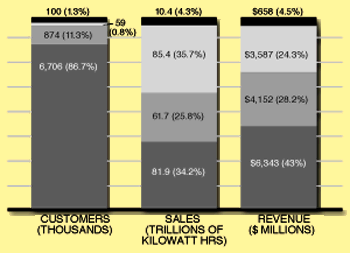
Utilities in Texas sold $14.7 billion worth of electricity to 7.7 million customers in 1992. Texas' 59,000 industrial users, only one percent of all customers, provided one-quarter of all revenues and used more than one-third of all power sold.
Total electricity consumed in 1992: 239.4 trillion kilowatt hours. One kilowatt hour equals the energy consumed by ten 100 watt light bulbs burning for one hour.
Source: Texas Public Utility Commission.
In 1942, Dr. Enrico Fermi assembled enough uranium to cause a nuclear fission reaction. Nine years later, in 1951, the first electric power was produced from the atom, when an experimental reactor lit up four light bulbs in a laboratory experiment. Today, more than half of all Texans rely on nuclear power as one of their sources of electricity. But the debate continues over how successful Texas' experiment with nuclear power has been.
Texas now has 4,802 megawatts of installed nuclear power capacity coming from two plants: the 2,300-megawatt Comanche Peak project in Somervell County and the 2,502-megawatt South Texas Project in Matagorda County. The combined cost of constructing the two facilities was $15.6 billion.(77) Part of the reason the plants were so expensive was that construction took many years longer than expected. The two units at Comanche Peak were under construction longer than any nuclear plant now operating in the U.S. Comanche Peak Unit Two got a construction permit in December of 1974, but did not begin operating until August of 1992.(78)
Concerns about safety and construction procedures have also hampered the South Texas Project in Matagorda County. The project got underway in 1975 and began generating power in 1988. It ran ten months before a fire caused the reactor to be shut down for six weeks.(79) The plant was closed for most of 1993 after Nuclear Regulatory Commission inspectors discovered problems with maintenance, security and management at the plant. The facility came back on-line in February of 1994, only to shut down a few days later due to a faulty water pump. The plant is now re-opened but under close scrutiny by the NRC to prevent further problems.
In 1992, the South Texas Project and Comanche Peak generated nearly 24.5 billion kilowatt hours of electricity, which accounted for more than 10 percent of all the electricity consumed in the state.(80) While the two plants are the only nuclear generating stations in Texas, many state residents consume electricity from nuclear plants located in other states. For instance, El Paso residents may get power from the Palo Verde nuclear plant in Arizona. Many East Texas residents use Louisiana's River Bend nuclear plant for electricity. In all, about 10 million Texans rely on utilities that produce nuclear power.(81)
Some anti-nuclear groups continue to advocate shutting down the nuclear plants immediately. They argue the move would save money for ratepayers over the long term because nuclear plants pose safety problems that could be very expensive to resolve. For instance, an accident like the one that occurred at the Chernobyl plant in the former Soviet Union could cost hundreds of millions of dollars. In addition, they say the long-term storage costs of radioactive waste are too expensive.
However, nuclear power proponents point out that when operated correctly, nuclear plants emit little or no carbon dioxide. And they say that the plants will save ratepayers money over the long term because the fuel costs for nuclear power plants are far less than fuel costs for conventional fossil fuel plants.
Disposing of radioactive waste from nuclear plants does present a difficult long-term problem. Texas used to send its low-level radioactive waste to a facility in Barnwell, South Carolina. However, that facility has reached its capacity. Low level radioactive waste is now stored above ground at each facility. The state of Texas plans to locate a low-level nuclear waste disposal site in Hudspeth County, but many local residents oppose the project. And even if the facility is approved, it will not open until the late 1990s.(82)
Under Texas law, low-level radioactive waste is defined as waste having a half life of 35 years. By law, all nuclear waste other than used fuel rods from power plants is classified as "low-level." These waste include items such as workers' discarded gloves and paper booties, as well as radioactive cooling water pipes and valves. These waste must be kept isolated for hundreds, if not thousands, of years in areas that are arid, geologically stable, and can be secured for centuries.(83) Low-level storage facilities must monitor disposal sites for at least 350 years to assure that the waste returns to background levels of radioactivity.(84)
A nuclear reactor produces about 30 tons of high-level and low-level radioactive material per year that must be stored safely.(85) The most dangerous of these waste are spent fuel rods. The highly radioactive fuel rods are even more problematic than low-level waste. The U.S. Department of Energy has proposed a final storage site for the fuel rods at Yucca Mountain, Nevada. However, the site is still being investigated for its suitability and even if it is approved, it will not be ready to accept the spent fuel rods until 2010 at the earliest.(86)
Decommissioning, or shutting down the power plants, presents another long-term problem for the nuclear power industry. Shutting down Texas' nuclear plants will likely cost consumers several billion dollars. The exact cost of decommissioning the plants is unknown because none of the large generators has been decommissioned yet. However, state officials estimate that disposing of low-level waste from a decommissioned plant could cost up to $250 million.(87) Labor costs and other costs could make the final cost several times that figure. Indeed, the few power plants that have been shut down have cost as much to decommission as they did to construct.(88)
No new nuclear power plants have been ordered in recent years. But new regulations under the National Energy Policy Act of 1992 could make it easier for utilities to build new nuclear generating stations.(89) Before any new plants are built, however, the public will have to be convinced that viable waste disposal options are available for radioactive waste. In addition, citizens will have to be convinced that the plants are safe, cost competitive and that the mistakes of earlier projects will not be repeated.
The nuclear power industry depends on uranium. For decades, Texas was a leading producer of this heavy, silvery-white element which can also be made into nuclear weapons. In the mid-1970s when the price of uranium was more than $40 per pound, nearly a dozen companies were operating some 35 uranium-mining sites in seven South Texas counties. Today, with the price at about $10 per pound, only a handful of companies continue to produce uranium in the state.(90)
Uranium used to be strip mined with technology similar to that used in coal mining. These uranium strip mine operations created large areas requiring remediation. Large tailings ponds have been created to contain the radioactive materials. These ponds, located in Karnes and Live Oak Counties, may pose a long-term threat to surface water and subsurface aquifers because they are subject to leakage. Federal law requires the tailings ponds, which contain materials that will remain radioactive for more than 1,600 years, to be covered, so that rainwater does not mix with the radioactive waste. However, these pond coverings may be eroded over time by water and wind, which could allow radium to escape into the atmosphere. The ponds must be monitored for centuries to assure that they are properly containing the radioactive waste.
Today, most uranium mining is done with injection wells, which pump fluid through the geologic formations where the mineral is found. Production wells then bring the uranium-bearing solution to the surface. Called "solution mining" or "in-situ" mining, this method causes relatively little disturbance of the surface. However, this process can contaminate groundwater, which must then be disposed of by injection into deep formations below fresh water aquifers.

NEXT PAGE * PREVIOUS PAGE Go to page 1*2*3*4*5*Notes

Please send questions, comments, or problems with this page to ltarver@mail.utexas.edu.